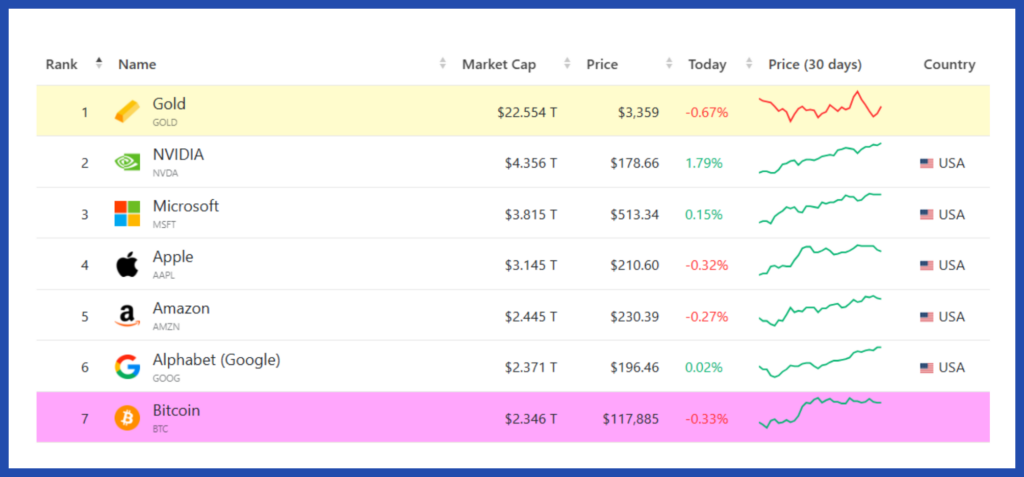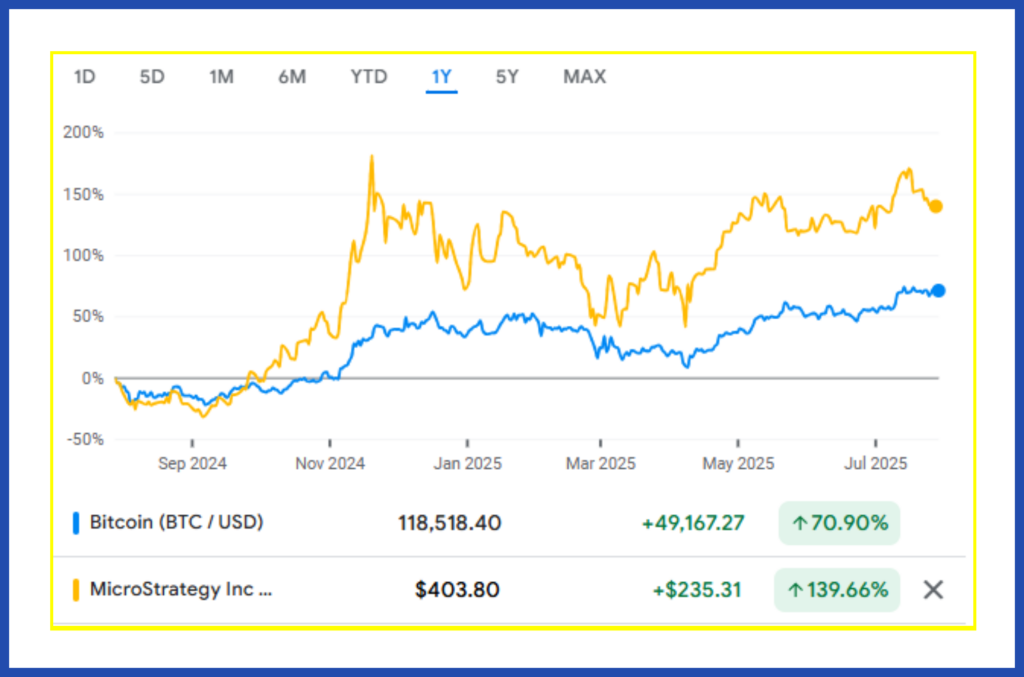Could bitcoin reach $200,000 by the end of 2025?
Bitcoin is the seventh-largest global asset—can it keep rising? Plus, ETH’s resurgence, and whether investing in MSTR is a better bet than bitcoin itself.
Advertisement
Bitcoin is the seventh-largest global asset—can it keep rising? Plus, ETH’s resurgence, and whether investing in MSTR is a better bet than bitcoin itself.

Welcome to the Canadian Crypto Observer. Financial journalist and author Aditya Nain offers perspective on market-moving headlines to help Canadian investors navigate the cryptocurrency market.
In case you missed it, bitcoin (BTC) is now the seventh-largest asset in the world by market capitalization. Here’s what’s ahead of it.

The prices of Bitcoin (BTC), ethereum (ETH), XRP and other cryptocurrencies have been on a tear this year on the back of various factors, the most significant being the passing of the GENIUS Act in the U.S. This Act regulates U.S.-dollar stablecoins—cryptocurrencies pegged to the U.S. dollar, such as Tether (USDT) and USDC—and in doing that, takes a major step towards regulation of crypto in the world’s largest market, the U.S.
Let’s put crypto’s price rise into perspective. The table below compares the percentage gain of the top three cryptocurrencies with the U.S. stock market (S&P 500), the Canadian stock market (S&P/TSX Composite), and gold (GLD). (Use your fingers or mouse to scroll to the right.)
| Bitcoin (BTC) | Ethereum (ETH) | XRP | S&P 500 Index | S&P/TSX Composite Index | Gold (GLD) | |
|---|---|---|---|---|---|---|
| Gain this year | 26.66% | 14.5% | 50.91% | 8.88% | 10.07% | 24.44% |
| One-year gain | 74.05% | 17.4% | 429.12% | 16.95% | 20.31% | 38.62% |
| Five-year gain | 902.32% | 1,000.53% | 990.14% | 94.34% | 69.49% | 64.70% |
2025 has been great for crypto investors—but is the party over, or could BTC and other crypto prices continue to rise? According to Tom Lee, a renowned Wall Street analyst and bitcoin bull, BTC could rise to as much as $200,000 to $250,000 (all figures in U.S. dollars) by the end of 2025. His view is premised on continued low interest rates, further addition of bitcoin to corporate treasuries, and strong ETF inflows.
If previous crypto market cycles are anything to go by, Lee’s prediction of $200,000 may not be a pie in the sky. In previous crypto bull market cycles, the market topped out at the end of the year following the bitcoin halving event. “Halving” is a four-year cyclical event in which the number of coins mined per block decreases by 50%—meaning the rate at which new coins are added into circulation is cut in half.
The table below shows what percentage BTC has gained at each market-cycle peak compared to its previous market-cycle peak.
| Halving date | BTC market-cycle peak | Approximate BTC peak (USD) | % gain from the previous high |
|---|---|---|---|
| November 2012 | November 2013 | $1,200 | n/a |
| July 2016 | December 2017 | $20,000 | 1,566% |
| May 2020 | November 2021 | $70,000 | 260% |
| April 2024 | ? | Current high: $123,091 (July 14, 2025) | 75% so far |
Based on this data, it could be reasonable to expect BTC to touch about $161,000 by the end of 2025. Here’s the simple back-of-the-envelope logic: BTC’s risk-return profile has moderated as its adoption has grown. Meaning, its highs and lows are not as pronounced as they were in previous cycles—although they’re still extreme compared to major stock indices.
So, let’s say BTC gains half of the percentage it gained in the previous cycle. Meaning, it gains 130% from its previous cycle top—not 260% as it did last time. That would take it to $161,000. Given that the previous cycle tops have been in November or December of the year following the halving, we could be looking at about $161,000 by the end of this year. Of course, forecasts or predictions like this could be way off the mark—take them with a grain of salt.
A few months ago, crypto analysts and experts were wondering whether ETH still warrants a place in crypto portfolios because of its substantial underperformance compared to BTC. Not anymore. As of July 28, ETH has gained 56.91% in just the past month—going from $2,424 to $3,803—and it could be poised to finally surpass its November 2021 high of about $4,900. (All figures in U.S. dollars.)
What’s driving ETH’s resurgence? Tokenization of real world assets (RWAs). That’s the process by which traditional assets such as fiat currencies, funds, bonds, real estate, or gold are being represented by blockchain-based tokens. This has at least four advantages:
Ethereum has benefited from the tokenization of traditional financial assets such as Treasury Bills and U.S. dollars (as in U.S.-dollar stablecoins like USDC that run largely on Ethereum). The table below lists some examples of tokenized RWAs on Ethereum (does not include stablecoins).
| Institution | Product | Asset tokenized | Launched |
|---|---|---|---|
| BlackRock | BUIDL | Money market fund | March 2024 |
| Franklin Templeton | BENJI | U.S. bond fund | April 2023 |
| VanEck | VBILL | U.S. Treasury fund | May 2025 |
| Société Générale | FORGE | Green bonds | November 2023 |
Ethereum has emerged as the blockchain of choice for the tokenization of RWAs. And tokenization is just getting started. Not only will the number of BUIDL-type funds and stablecoins grow, but other major asset classes such as real estate, bonds, private credit, and stocks are also being tokenized. If ethereum continues to be the blockchain of choice for the tokenization revolution, who’s to say where the price of ETH will be in the next five years?
We’ve ranked the best crypto exchanges in Canada.
Canadian investors are lucky to have access to a slew of Canadian and U.S.-based crypto ETFs that hold BTC, ETH, XRP, SOL, or a combination of these. Check out my previous columns for an exhaustive list of crypto ETFs.
But there’s another way to get exposure to BTC that’s becoming increasingly popular: buying shares of Strategy (MSTR), Michael Saylor’s Nasdaq-listed bitcoin treasury company. A bitcoin treasury company is a firm that holds a significant chunk of its corporate reserves in BTC. MSTR has invested billions of dollars in bitcoin and owns 607,770 BTC as of July 2025—that’s over 3% of the total BTC in circulation.
The primary aim of a BTC treasury company—pioneered by MSTR—is to preserve long-term value for shareholders through investing in BTC as a growth asset expected to outpace inflation. MSTR aims to do this by increasing its BTC per share. To achieve this, it accumulates more BTC by issuing debt against its existing BTC holdings. You could think of it as a leveraged long position on BTC. Sounds risky? It is. MSTR aims to give investors more bang for their buck, meaning that it wants its shares to outperform BTC itself—and so far, it has.
As the table below shows, over the past year, MSTR’s share price performance is almost double that of BTC itself. The yellow line is MSTR and the blue line is BTC.

Double the gain is amazing, but that doesn’t necessarily mean MSTR is a better way to get BTC exposure. Individual investors may not fully understand the inner workings of MSTR and its associated risks. And when you don’t understand something, it’s easy to get swayed by the latest news or social media content, leading to hasty or rash investment decisions. So, for simple, direct exposure to BTC, ETH, XRP, SOL, or other cryptocurrencies, ETFs are probably still the way to go for most individual investors in Canada.
Cryptocurrencies like BTC, ETH, XRP, SOL, and others are speculative and highly volatile assets that are subject to significant price swings. Even the seemingly “safe” stablecoins may not be “safe” if not backed adequately by real-world assets.
Investing in bitcoin and other crypto coins carries significant market, technological, and regulatory risks. Invest in crypto only if it aligns with your investment goals, time horizon, and risk profile, and stay vigilant about crypto scams.
Share this article Share on Facebook Share on Twitter Share on Linkedin Share on Reddit Share on Email